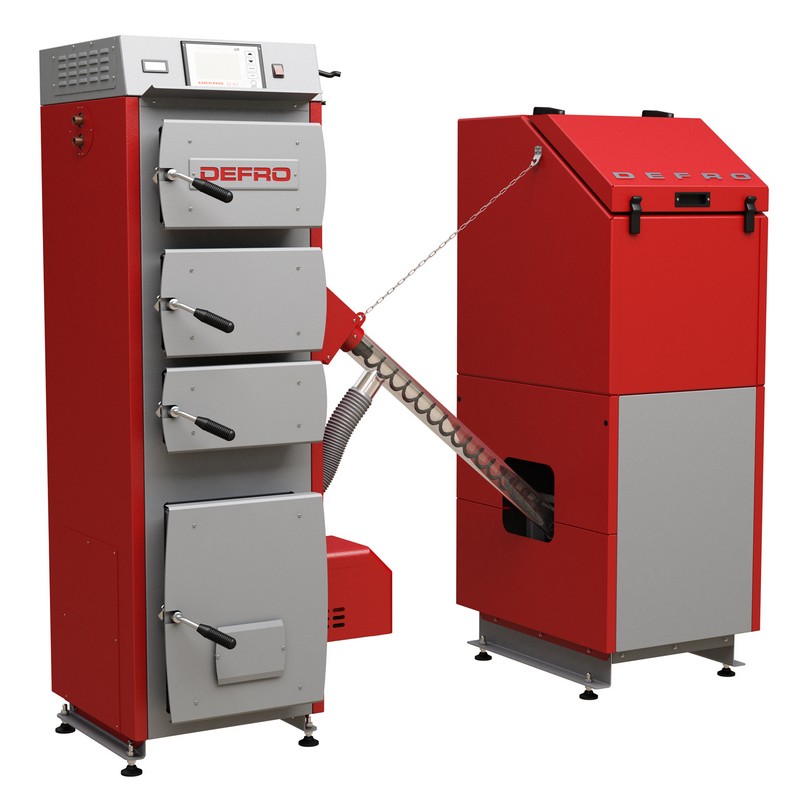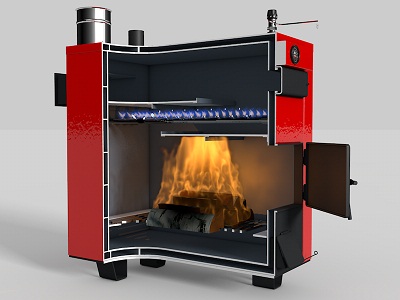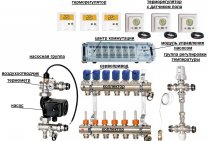The choice of solid fuel unit
After analyzing the cost of heating in various ways, I settled on a solid fuel coal heating boiler. Indeed, the cost of diesel fuel and electricity is constantly rising. At present, heating with coal is about four times cheaper than with diesel fuel or electricity. Gas is also not an alternative, since it is very expensive to conduct it due to the notorious corruption component. The cost of gas inevitably tends to the world price, as Gazprom understands it. The pressure of gas in pipes in many areas at the peak moments (at extremely low temperatures) drops so that the boilers are turned off and the houses freeze.
The main disadvantage of a coal-fired boiler is the need to regularly (2-3 times a day) load it with fuel. If you agree to this, then a solid fuel boiler is your choice. Before installation, you need to decide on the power of the boiler, the place of its installation, the piping scheme from it and the system for ensuring the circulation of the coolant.
|
Here is a selection of materials for you: VEverything you need to know about heating and climate control Features of the selection and maintenance of boilers and burners. Comparison of fuels (gas, diesel, oil, coal, firewood, electricity). Do-it-yourself ovens. Heat carrier, radiators, pipes, floor heating, circulation pumps. Chimney cleaning. Conditioning |
Solid fuel pyrolysis gas-generating boilers of long burning
The operation of such boilers is based on the gasification of fuel. The furnace of such a boiler is divided into 2 halves horizontally. The upper half, which is also a loading chamber for fuel, firewood does not burn, but smolder. Being exposed to high temperatures, firewood emits various combustible substances, which become the main fuel for the boiler, burning in the second chamber located below.

The described principle of operation of boilers significantly increases the efficiency of such samples, in this case we can talk about 85 or even 90%. The burning time of the fuel also increases significantly, reaching up to 12 hours. The fact is that in the boilers under consideration, the process of direct combustion of fuel occurs only in the lower chamber.
In the upper, loading chamber, firewood only smolders, releasing combustible substances. After that, combustible substances are mixed with air and sent through a special nozzle to the second, lower chamber, where they become the main fuel for such a boiler. In the process of burning a mixture of air and gases emitted from firewood, it is possible to reach sufficiently high temperatures, therefore the lower chamber, in which the combustion process takes place, is sheathed with a special heat-resistant finish.
The fuel in the boilers under consideration burns out almost completely, which also allows us to talk about the efficiency of the boiler. In addition, due to its technical features, the boiler does not form soot and ash during operation. In order for the pyrolysis boiler to fully perform its functions, it is necessary to fully pump air into the device.
The boilers in question are complex and expensive equipment. In most cases, the design of such boilers includes:
- smoke exhausters;
- Electronic devices for managing the working process of the boiler and effectively monitoring it.
 An important condition for the correct operation of the pyrolysis boiler is the level of moisture in the fuel. The moisture content of firewood, which will be laid in such a boiler, should not exceed 25%.Practice shows that firewood stored in a woodpile can boast such a percentage of moisture only 24 months after the start of storage. Also, the boiler is demanding on the size of the fuel: the thickness of the firewood that is being prepared for laying in such a boiler should not be less than 100 millimeters. The minimum power of the boiler, which can be considered under control, is 50%, in cases where the power of the boiler falls below the indicated indicator, the operation of the device becomes unstable. This suggests that the boiler is well adapted to work in the cold periods of the year, but is completely unsuitable for efficient operation in the off-season.
An important condition for the correct operation of the pyrolysis boiler is the level of moisture in the fuel. The moisture content of firewood, which will be laid in such a boiler, should not exceed 25%.Practice shows that firewood stored in a woodpile can boast such a percentage of moisture only 24 months after the start of storage. Also, the boiler is demanding on the size of the fuel: the thickness of the firewood that is being prepared for laying in such a boiler should not be less than 100 millimeters. The minimum power of the boiler, which can be considered under control, is 50%, in cases where the power of the boiler falls below the indicated indicator, the operation of the device becomes unstable. This suggests that the boiler is well adapted to work in the cold periods of the year, but is completely unsuitable for efficient operation in the off-season.

The combustion process of solid fuels is divided into three stages
- ignition (ignition),
- active combustion
- afterburning.
- In the first stage, solid fuel is first heated and dried, and at a temperature of 105 - 110 ° C, it loses its moisture.
- Then, at a temperature of 300 - 400 ° C, it begins to decompose into volatile substances and a solid residue.
- With further heating, when its temperature becomes equal to the ignition temperature, the fuel ignites. The ignition temperature (approximate) of various fuels is as follows, ° С: firewood - 300; brown coal - 300 - 400; coal - 450 - 500; anthracite - 700 - 750; liquid fuel 500 - 600; about 600 gas.
- The stage of active combustion is characterized by a high temperature (over 1000 °C) with maximum heat release and the highest consumption of air (oxygen) consumed for the combustion of coke and volatile substances.
- The afterburning of solid fuels is characterized by decreasing heat release and decreasing air demand.
Solid fuel boilers, combustion in which occurs naturally
Boilers of this type differ from analogues in that all the firewood that was placed in the furnace burns simultaneously, that is, the process of burning solid fuel, in this case, firewood, occurs naturally.
The advantages of boilers of this type traditionally include a simple design and low cost of the product. Such a boiler is indulgent to the quality of firewood and does not cause difficulties in the maintenance process, which can also be attributed to the asset of the device.
The operator of such a boiler can control the power of the device, but this figure can vary between 60 and 100% efficiency, the specific figure depends on how intense the burning is. The intensity of combustion is regulated by a special damper, which limits the ingress of air into the boiler. Along with the power, the efficiency of the apparatus inevitably decreases.
Practice shows that the maximum efficiency that such boilers can boast of is 80%. Speaking about the disadvantages of solid fuel boilers with a natural type of fuel combustion, it is customary to recall that the process of fuel combustion occurs as soon as possible. As a rule, one batch of firewood placed in the boiler is enough for no more than 4 hours.

Methods for supplying secondary air to the furnace
- Secondary air supply through the furnace door.
- Secondary air supply through a special hole in the furnace body.
- Secondary air supply through the silo.
- Secondary air supply through a special brick channel inside the furnace.
1. Supply of secondary air through the furnace door.
The most common way to supply secondary air to the furnace.
Many modern oven doors have special openings on their body for air to pass into the furnace. Usually these openings are conveniently closed with a slide gate. This valve regulates the amount of air supplied.
2. Secondary air supply through a special hole in the furnace body.
The advantage of this method is that it is possible to supply exactly to the place of accumulation of unburned substances.
The difficulty is that it is not easy to determine such a magical place in the oven.
And the biggest difficulty is the discrepancy between the hole in the furnace and fire safety standards.
3. Secondary air supply through the silo.
A silo is a channel for the passage of air from the furnace blower to the secondary air supply area. The silo is made of stainless steel and installed in the furnace with compensation gaps for possible expansion.
To arrange the supply of secondary air through the silo is a rather technical and modern solution in the construction of furnaces.
For a competent arrangement of silo in a furnace, it is important to understand the combustion processes in the furnace and the consequences of the impact of fire on materials. In fact, few stove-makers use this method, because
this is a rather complex undertaking requiring the clarity of the project and the good quality of the material of the silo
In fact, few stove-makers use this method, because. this is a rather complex undertaking requiring a clear design and good quality of the silo material.
4. Secondary air supply through a special brick channel inside the furnace.
A good way to supply secondary air, provided there is enough space inside the oven.
I usually fail to place another secondary air duct inside the oven.
Usually you design a stove with maximum power in a minimum size and there is simply no room for an air duct, but if you are not limited in size, then making a brick secondary air duct would be a good solution.
Perhaps there are some more exotic ways to supply secondary air to the furnace.
 Heating fireplace stove
Heating fireplace stove
It is easier and easier to put a door with holes and a gate, this method works and does not require any tricks.
The principle of operation of a solid fuel boiler
Due to the temperature difference between the gases in the chimney and on the street, draft is created (that is, a pressure difference). This pressure difference creates a negative pressure in the boiler, which causes air to enter the boiler through the air inlets. There are usually two holes for air supply: a damper for primary air and holes for secondary air (sometimes they are called tertiary air holes, assuming that there is still a channel for secondary air inside the boiler, but we will call this air secondary). Why is it necessary to separate the primary and secondary air flows? The fact is that we would like to regulate the power of the boiler over a wide range. If the rooms are cool, then the boiler should heat more strongly, if it is warm, then weaker. The adjustment is carried out by changing the primary air supply, that is, if we want to reduce the boiler power, then we supply less air. With this approach, the fuel begins to burn incompletely, which reduces efficiency and harms the environment. This is where secondary air comes in handy. It is added to the heated gaseous products of combustion and burns them out.
So, the vacuum in the boiler, which has arisen due to draft in the chimney, sucks the primary air into the chamber with fuel. The fuel is partially burned. Combustion products are mixed with secondary air and oxidized. The resulting gases pass through the channels of the boiler, giving off heat to the coolant, and enter the chimney, maintaining the temperature necessary to create draft in it. This is how the boiler works in stationary (cruising) mode.
(read more…) :: (to the beginning of the article)
| 1 | 2 | 3 | 4 | 5 | 6 | 7 | 8 | 9 |
:: Search
Unfortunately, errors occur periodically in articles, they are corrected, articles are supplemented, developed, new ones are being prepared. Subscribe to the news to stay informed.
If something is not clear, be sure to ask! Ask a question. Article discussion. messages.
Hello. I want to buy a house, there is a thermal power plant nearby, which works on coal at a distance of 500 meters. According to the wind rose, it does not blow in our direction, but in the other. How dangerous is it? What is formed when coal is burned? Read answer...
More articles
Cleaning the coal boiler...
Cleaning the coal boiler. Practical advice. My experience….
Heating with coal, experience…
Coal heating experience. Warm, comfortable, but troublesome. The comfort and safety of coal…
Knitting. Three together facial (by rearranging loops - central ...
How to knit a combination of loops three together with the front (by rearranging the loops - ...
Knitting. Moths. Patterns, drawings...
How to knit the following patterns: Moths. Detailed instructions with explanations ...
Correction of errors in the foundation ....
How to fix the mistakes made when pouring the foundation ...
Do-it-yourself automatic heating burner. Waste oil...
The design of a home-made automatic heating burner is being worked out ....
Choice of yarn. Properties, signs, characteristics, types, types. Choose n…
How to choose yarn to knit? Checking the composition of the thread (wool, cotton, synthetic ...


